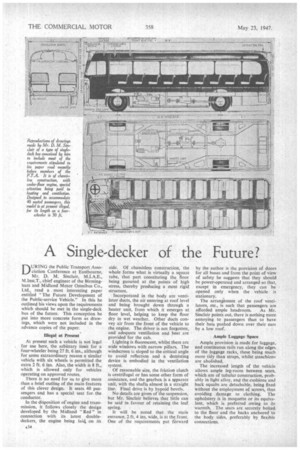A Single-decker of the Future?
Page 44

If you've noticed an error in this article please click here to report it so we can fix it.
DURING the Public Transport Association Conference at Eastbourne, Mr. D. M. Sinclair, M.I.A.E., M.Inst.T., chief engineer of the Birmingham and Midland Motor Omnibus Co., Ltd., read a most interesting paper entitled " The Future Development of the Public-service Vehicle." In this he outlined his views upon the requirements which should be met in the single-deck bus of the future. This conception he put into more concrete form as drawings, which were not included in the advance copies of the paper.
Illegal at Present At present such a vehicle is not legal for use here, the arbitrary limit for a four-wheeler being 27 ft. 6 ins., although for some extraordinary reason a similar vehicle with six wheels is permitted the extra 2 ft. 6 ins. Also, the width is 8 ft., which is allowed only for vehicles operating on approved routes.
There is no need for us to give more than a brief outline of the main features of this clever design. It seats 40 passengers and has a special seat for the conductor.
In the disposition of engine and trans. mission, it follows closely the design developed by the Midland " Red " in connection with its latest doubledeckers, the engine being laid, on its
side. Of chassisless construction, the whole forms what is virtually a square tube, that part constituting the floor being gusseted at the points of high stress, thereby producing a most rigid structure.
Incorporated in the body are ventilator ducts, the air entering at roof level and being brought down through a heater unit, from which it emerges at floor level, helping to keep the floor dry in wet weather. Other ducts convey air from the front of the vehicle to the engine. The driver is not forgotten, and adequate ventilation and heat are provided for the cab.
Lighting is fluorescent, whilst there are wide windows with narrow pillars. The windscreen is sloped to the critical angle to avoid reflection and a demisting device is embodied in the ventilation system.
Of reasonable size, the friction clutch is centrifugal or has some other form of assistance, and the gearbox is a sgparate unit, with the shafts almost in a straight line. Final drive is by hypoid bevels.
No details are given of the suspension, but Mr. Sinclair believes that little can be said in favour of retaining the leaf spring.
It will be noted that the main entrance, 2 ft. 4 ins, wide, is at tilt! front. One of the requirements put forward by the author is the provision of doors for all buses and from the point of view of safety he suggests that they should be power-operated and arranged so that, except in emergency, they can be opened only when the vehicle is stationary.
The arrangement of the roof ventilators, etc., is such that passengers are afforded ample headroom. As Mr. Sinclair points out, there is nothing more annoying to passengers than to have their hats pushed down over their ears by a low roof.
Ample Luggage Space Ample provision is made for luggage, and continuous rails run along the edges of the luggage racks, these being much more tidy than straps, whilst stanchions are abolished.
The increased length of the vehicle allows ample leg-room between seats, which are of tubular construction, probably in light alloy, and the cushions and back squabs are detachable, being fixed without the employment of screws, thus avoiding damage to clothing. The upholstery is in moquette or its equivalent, which is preferred owing to its warmth. The seats are securely bolted to the floor and the backs anchored to the body sides, preferably by flexible con n ections.












































































